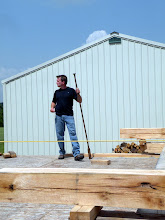This was the first drawknife I ever bought. Ray Larsen who operated Genuine Forgery made this knife. Many of you may have this knife. I think it was inspired by The Windsor Institute which Ray ,before his retirement ,has sold many of this knife. I also have his scorp and really like the geometry of that tool. I see this drawknife from time to time pop up in classes that I teach. I really liked the knife when I first used it many years ago but have since let it collect dust as I have found better knives to replace it.
As you can see below this knife is ground to a knife edge. The handles are set in a neutral position which allow you to use this drawknife up or down. The biggest problem I have with this knife is how hard it is to sharpen and also it seems to dive down into the cut. I really like the quality of this knife and I think with a few changes in geometry this knife can perform really sweet.The first thing I do is hollow grind the back of the blade. The back is the side not stamped "Genuine Forgery". I use an angle grinder to hollow out the back which allows me to flatten the back easier. My goal is to make this knife a bevel up user.
After lots of grinding and working across my water stones I manage to get the back really flat as you can see below which I finish to an 8000 grit stone.
Then I simply use my jig on the slow speed grinder to make a hollow grind bevel on the top side of the knife. The I sharpen like I would any antique knife until I get a very sharp edge.
After the knife is razor sharp I cold bend the handles very slightly down to make the knife work as a bevel up knife. I like the bevel up knife because it follows the long grain wood fibers very nice when making chair spindles. I love the results and really like the idea I have taken a drawknife I never use and made it sing once again. I think Ray Larsen would be proud.
Here is the final shot of the youth chair with the black over red milk paint. Once I get the walnut table done I will deliver these to North Carolina. "Road Trip!!!"








I'm curious what kind of jig you use for grinding. Is it like the Galbert jig?
ReplyDeleteI'm also wondering how difficult is it to cold bend the handles. I have an old Witherby drawknife with turned-down handles. I'm thinking about bending them parallel to the blade so I could use it bevel down. Do you just put the blade in a vise and pull on the handle, or what?
Yes, the adjustable grinding jig that Galbert mentions on his blog. I use the prototype that we made at Kelly Mehler's two years ago. I have had some luck bending handles cold if you don't have to go too far. Some knives have softer metal around the handles which bend great and I have had some that would not budge. If that is the case then you have to heat the area of the handle to bend. Not always easy with wood handles so close. Thanks for posting,
ReplyDeleteGreg